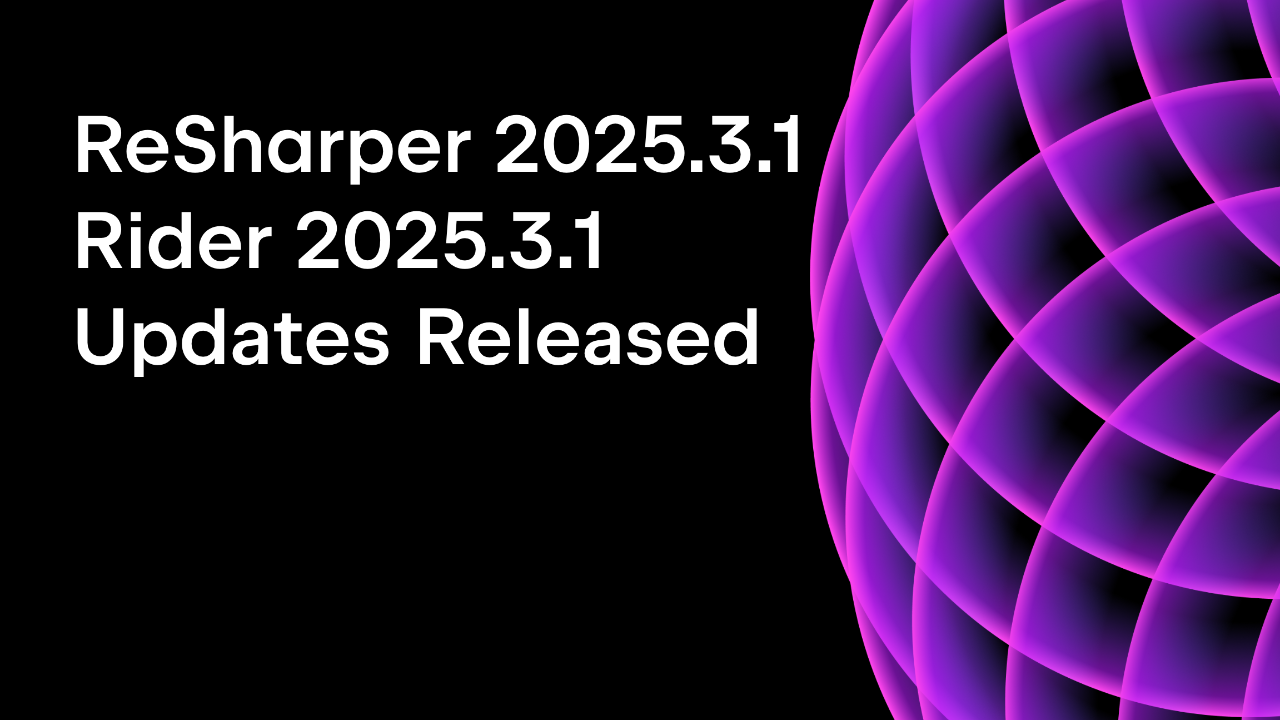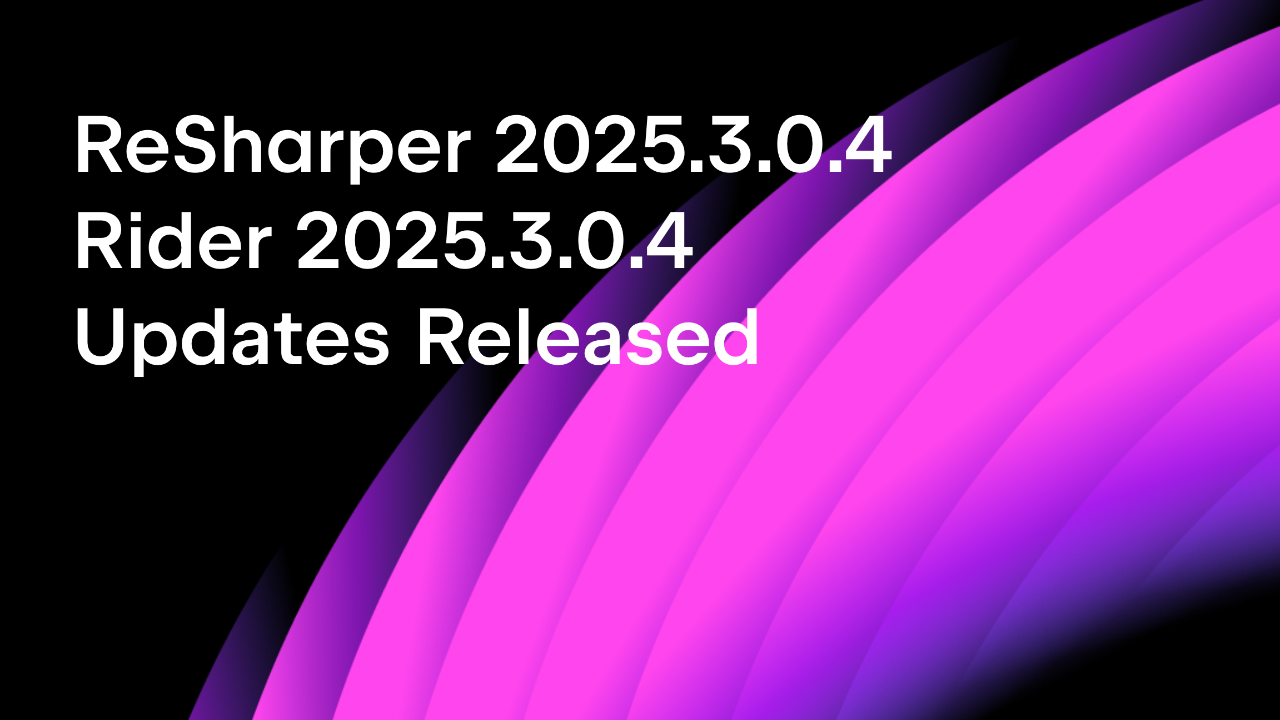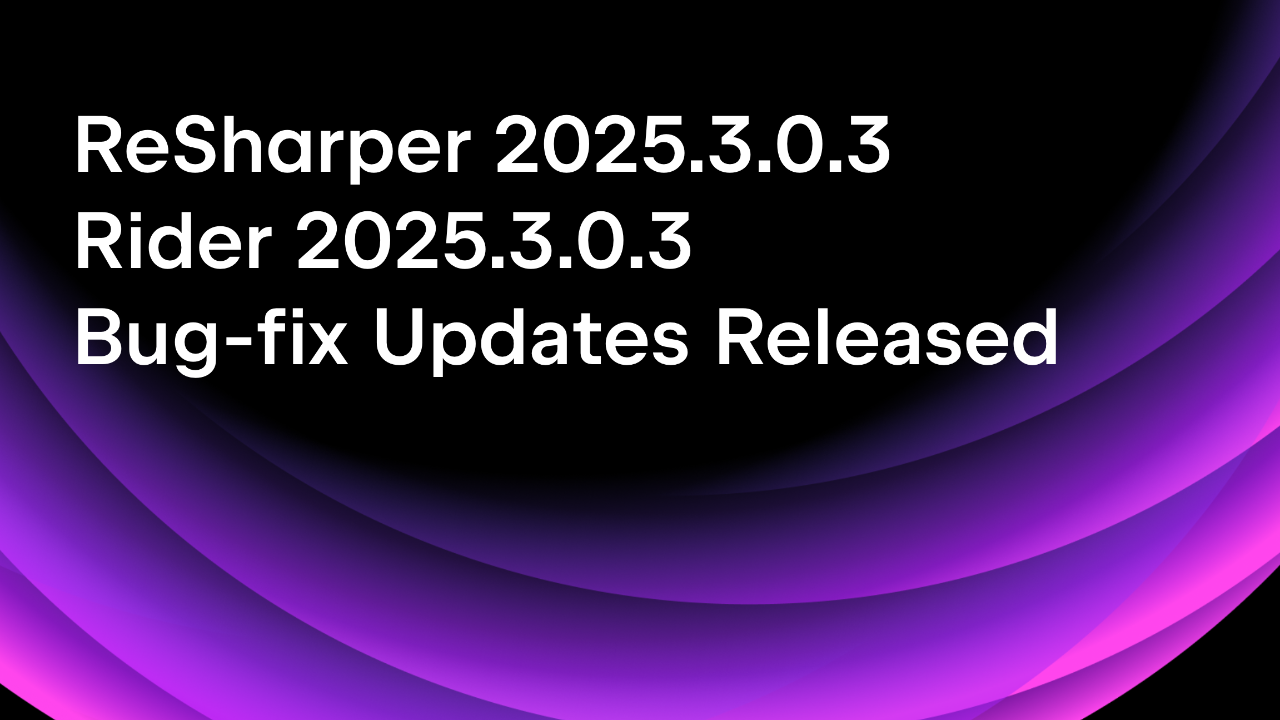.NET Tools
Essential productivity kit for .NET and game developers
Rider Roadmap: What to Expect From the Upcoming Updates and Releases
With Rider 2025.2 already out in the wild and the 2025.3 release cycle underway, we want to take a step back and give you a broader picture of where Rider is headed.
This roadmap covers our plans for Rider 2025.3 and what you can expect from the minor updates included in the 2025.2 release line. Think of it as a look at the near horizon – both what’s already in your hands and what’s right around the corner.
Same-day release with .NET 10
One of our biggest goals for Rider 2025.3 is to release it on the same day as .NET 10, like we did last year with .NET 9. We know how important it is for you to adopt the latest SDK without delay, and we’re working hard for Rider to be ready the moment .NET 10 becomes available. This, of course, also means immediate support for the newest updates to C#, so you can explore the latest syntax improvements, productivity features, and runtime enhancements as soon as they’re available.
Performance improvements
Performance remains our key area of focus, and for the next major release, we’re doubling down on making Rider faster out of the gate. For the past couple of releases, our efforts have been chiefly dedicated to improving memory consumption and refactoring Rider’s garbage collection. This time, we’ll be targeting warm startup scenarios, meaning we want to get you from launching Rider to writing code as quickly as possible. We’ll target the core IDE features that you need immediately, so there’s less waiting around for everything to initialize.
For Rider 2025.3 we’ve also refactored how Rider runs Roslyn analyzers when Solution-Wide Analysis (SWA) is enabled. In our internal measurements, Roslyn analyzer execution became 2–3x faster. On representative solutions this lead to a reduction of total SWA time by up to 20%. The exact improvement will vary by solution depending on which analyzers you use and how your analysis is configured.

This Roslyn case is part of a broader series of refactorings we’re making to ensure Rider feels snappier and more responsive across the board.
Fresh new look with the Islands UI theme
The new Islands UI theme, available in both light and dark modes, will soon be rolled out in one of our upcoming updates to Rider 2025.2. This redesign is focused on visual clarity, better separation of editor and tool windows, and an overall cleaner, more modern development environment. We’re hearing a lot of anticipation and positive feedback from users who have already tried it in preview builds, and so the plan now is to make it the new default UI in Rider 2025.3 after a final round of refinements.

In-IDE OpenTelemetry
Encouraged by the positive feedback the new OpenTelemetry plugin for Rider has been receiving, we’ll be working on refining and expanding its capabilities. For Rider 2025.3, we’re improving your experience working with OT traces, taking it from a bare-bones table view to a more informative and intuitive way to explore and examine all of the spans that belong to a trace in detail. This will give you a clearer understanding of your application’s runtime behavior during development, all without leaving your IDE.
But the most exciting news is that we’re working on bringing the OpenTelemetry plugin to other JetBrains IDEs. Bookmark this ticket to follow our progress, and let us know in the comments which IDE you’d like to see with integrated OpenTelemetry insights.
Game development
Game development continues to be a priority area for Rider, and we’re expanding our capabilities with several key areas of focus.
Unreal Engine: Performance and mobile development
Building on recent improvements to stepping times and refactorings for faster Blueprint indexing, we’re continuing to invest in making Unreal Engine development and debugging in Rider faster and more reliable. We’re also investing our resources into improving remote debugging workflows and NatVis support for the native code debugger.
Rider is venturing into Unreal Engine mobile development. Mobile game development has its own quirks and workflows that desktop development doesn’t cover, so we’re starting work on extending our UE tooling to handle those scenarios properly.
Another goal of ours is to unify the mobile game development experience between Unity and Unreal Engine, so you can expect Rider to provide consistent workflows, debugging capabilities, and deployment options regardless of which engine you’re using.
Unity: Deeper integration and better UX/UI
Speaking of better workflows, one of our plans for Unity mobile development is to update the UI for attaching the debugger to Unity games running on mobile devices. This will make it easier for you to select and attach to mobile devices, be they iOS or Android, directly from Rider.
Unity Profiler integration is also getting more polish. We laid the foundation in version 2025.1, and now we’re refining the in-editor experience. The goal is to make your game’s performance profiling feel native to your development process rather than a separate workflow you have to context-switch into.
The Frame Viewer tool for shader debugging, introduced in v2025.2, will also get some attention. Graphics debugging is notoriously tricky, so we’re adding deeper shader inspection capabilities to help you track down those pesky rendering issues.
Godot: GDScript support keeps getting better
For Godot developers, we have a large scope of improvements planned for GDScript support. These include parser stability, better debugging, richer IDE integration, and quality-of-life fixes across the board. Our goal is to move from basic syntax highlighting and error detection toward a first-class Rider experience for Godot game development, with smoother editing, clearer error reporting, and a more robust debugging workflow.
Better support for native projects
CMake support
We’ve heard your requests for CMake support in Rider, and we plan to start working on it for the 2025.3 release. The goal is to allow you to open, edit, and build CMake projects directly in Rider without having to switch to another build system in cross-platform projects. Our goal is for you to enjoy the same level of quality and functionality you already rely on when working with traditional .sln projects.
The initial rollout will focus solely on C/C++ projects, including the debugging of CMake configuration files. Support for C# projects referenced by CMake is not planned for this first version, as we want to ensure a robust foundation for C++ development first.
CMake support in Rider is being introduced specifically to support CMake-based game engines and other side workflows in the game development space. CLion will continue to be JetBrains’ primary IDE for general C++ and embedded development.
Code completion and highlighting in inactive preprocessor branches
Working with cross-platform C++ projects can be made easier through highlighting and completion for inactive code wrapped in #if, #else, or #endif directives disabled for the current build configuration. We’ve been addressing this need step by step. Rider 2025.2 introduced basic coding assistance inside inactive code, so features like completion and parameter info work even when the code isn’t currently active. Rider 2025.3 will take this further by adding code highlighting for inactive branches, making disabled code visually distinct in the editor so you can clearly see which parts of a file are active without sacrificing readability.
Full support for *.vcxproj.filters files
Another highly requested feature that made it onto our roadmap for the next major release of Rider is support for .vcxproj.filters files. Until now, Rider’s support was limited to only reading these files, which made collaborating with Visual Studio users difficult and sometimes broke project organization when files were added or removed. Starting with v2025.3, we’ll address this by implementing full read-and-write support. This will make it possible to create, delete, and move files within Rider without corrupting filter files, ensuring a seamless experience for teams mixing Rider and Visual Studio in their workflows.
Mixed-mode debugging
With Rider 2025.3, we’re bringing support for .NET Core applications as a new mixed-mode debugging capability on Windows. This will allow you to step seamlessly between managed and native code, inspect variables, and debug interop scenarios without switching tools.
Azure DevOps integration
For teams that live in the Azure DevOps ecosystem, we’re starting to bridge that gap with Rider. The first piece is repository cloning: you’ll be able to clone your Azure DevOps repos directly from within Rider without having to copy URLs or switch to a browser. We’ll be adding more baseline integration as time goes on, and the azd plugin is a great resources for additional Azure DevOps functionality. We’ll be keeping in touch with the plugin’s author to ensure a smooth experience as we progress.
NuGet Package Manager UI redesign
We’ve heard your feedback about the NuGet Package Manager UI, and we’ll be redesigning the workflow. Our goal is to make it much easier to update multiple packages at once, select specific sets of dependencies, and manage complex upgrades without falling back to external tools. The new design focuses on better discoverability, multi-select capabilities, and overall usability improvements.
NuGet Package Manager console
A highly-requested feature we’re setting out to implement for Rider 2025.3 is the NuGet Package Manager console.
The console will fully support all NuGet commands, such as Find-Package, Get-Package, Install-Package, and more, providing a complete terminal-based experience for managing packages. The commands are closely integrated with the IDE, allowing for a better and smoother workflow. We’re also working to support Entity Framework Core tools, enabling you to run commands such as Add-Migration and Update-Database within the same environment.
You’ll be able to manage packages, work with EF Core, interact with the IDE, and execute regular PowerShell commands within the same environment. No more switching between different tool windows, terminals, or other parts of the IDE to accomplish your tasks.
This roadmap outlines some of the key directions we’re pursuing for Rider. We’ll be sharing more details and updates as features mature, so stay tuned to our blog and join the Early Access Program to try them out first-hand.
We’re eager to hear your thoughts. Which improvements are you most excited about? Let us know in the comments or on our issue tracker.
Subscribe to a monthly digest curated from the .NET Tools blog:







